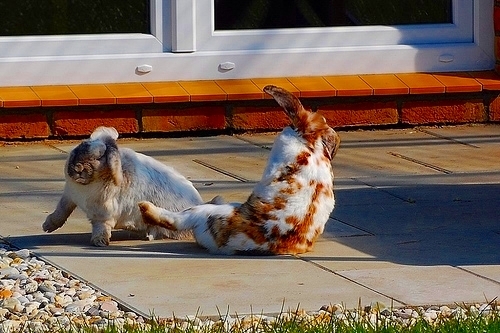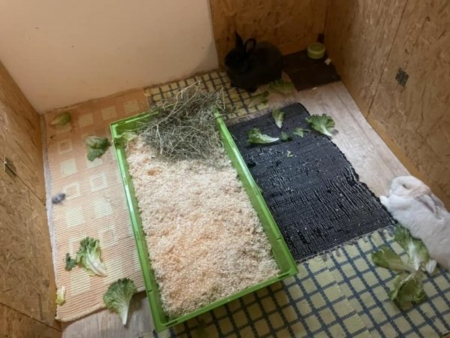
Contents
- Common Mistakes in Rabbit Bonding
- First, ‚let them sniff each other‘
- Placing the new rabbit in the territory of the established one
- Getting to know each other through bars
- Bonding of Same-Sex Rabbits
- Hasty Separation of Fighting Rabbits
- Cramped Living Conditions
- Unsuitable Setups with Dead Ends
- Bonding with Breaks
- Do Not Prevent Territory Formation
Common Mistakes in Rabbit Bonding
In most consultations, it quickly becomes apparent that the same ‚mistakes‘ are made repeatedly. Bonding rabbits is a significant challenge for most owners, which can also be very stressful. In an attempt to help the rabbits, actions are often taken that later result in the bonding failing. Additionally, there are many methods and recommendations that are widespread and can jeopardize or prevent the success of the bonding.
First, ‚let them sniff each other‘
Often, it is recommended to let the rabbits sniff each other to determine if they can ‚get along.‘ These recommendations significantly impact the later bonding process. When rabbits sniff each other, either through a barrier or by placing the new rabbit near the existing one or introducing them elsewhere, the bonding process has already begun. If the new rabbit is in the territory of the established rabbit, the resident rabbit vigorously defends its territory. Many owners are initially shocked and put the new rabbit back into its original enclosure. Sometimes, they may behave harmoniously but are still separated again. Some owners repeatedly try to introduce them under supervision, fearing they might fight when left alone. Some owners attempt to place the initially harmonious rabbits into the cage or enclosure where the old rabbit lives, and the resident rabbit usually attacks the newcomer, defending its territory. ‚Letting them sniff each other‘ is harmful to the later bonding process for several reasons:
- When rabbits are introduced to bond, they must not be separated afterward (see below). Every separation restarts the bonding process, and it may become more intense each time. Therefore, letting them sniff each other first, then separating them, and later reintroducing them usually does not work!
- Allowing rabbits to sniff each other without letting them establish dominance (e.g., through a separated barrier or by holding them) can provoke aggression in many rabbits. When later introduced normally, this aggression can lead to intense fights. Therefore, the recommendation is either to introduce them fully or have no contact at all.
- The territory of the established rabbit is defended, and in rabbit language, it is considered rude for the new rabbit to simply invade the territory of the resident rabbit. This can lead to fierce fights with injuries. Rabbits must always meet outside territories, in a completely unfamiliar area, get to know each other, establish dominance, and get along before being allowed back into the established territory.

Placing the new rabbit in the territory of the established one
Rabbits are highly territorial by nature, and even in the wild, rabbit groups respect invisible territorial boundaries very precisely. If they cross these boundaries, they are appropriately corrected. In nature, rabbits can escape back to their territory and leave the other rabbit’s territory in case of an attack. This is not possible in domestic pet keeping, so intense fights can lead to severe injuries. As a pet owner, one naturally does not want to provoke this, so especially inexperienced rabbit owners should never introduce their rabbits where the other rabbit has already been. If they have met outside the territory, they can later return to the territory. Imagine one day a complete stranger sitting in your living room on your sofa watching TV. You would probably be quite upset and try to throw them out of the apartment. Now, this stranger does not leave but stays in your apartment, eats your food, uses your bathroom, sleeps in your bed… You would probably become even more angry as this behavior is simply rude. Doesn’t he have any respect for your privacy and your right to live in this apartment? Now imagine that you meet the same person outside on the street, live somewhere else with him for a while, and establish a friendship. Now, wouldn’t you much rather have him live in your apartment?
Getting to know each other through bars
Often, it is recommended as a standard bonding method to initially keep rabbits in pens or cages next to each other and, once they have become accustomed to each other, allow them to be together. This bonding method is not the best for the beginning! Sniffing each other without being able to establish a hierarchy usually leads to fights, primarily at the bars but especially when the rabbits are later put together, resulting in severe injuries. This bonding method is only advisable for restricted/disabled rabbits or for rabbits that show no aggression at the bars. It can also be used for extremely difficult, unsocialized rabbits if other methods have already been exhausted. The method is by no means suitable for beginners or initially and can lead to severe injuries. Such bonding attempts often fail. See also bonding methods.

Bonding of Same-Sex Rabbits
One still hears the advice in pet stores, from breeders, and among private owners to keep same-sex rabbits to save on neutering costs or to prevent offspring. Unfortunately, this well-intentioned advice often goes awry because only a few same-sex pairs get along in the long run. Two females raised together often quarrel during puberty and end up being housed alone because owners don’t know how to resolve the situation differently. The cohabitation of two neutered males who grow up together can work, although they may go through a challenging phase during puberty. Groups of three with neutered males can be more complicated and may result in injuries during puberty. Unneutered males often suddenly start fighting after many harmonious months or even years, causing severe injuries, and in extreme cases, they may kill each other. They are particularly prone to injuring each other’s genitals. Later bonding of same-sex rabbits is only advisable if rabbits of the opposite sex are added to the group. Groups consisting only of neutered males or all-female groups are challenging to bond and not a good combination for beginners.
Solution: If you already have same-sex rabbits, they should be neutered as early as possible. Early-neutered males tend to be more compatible. If two neutered males have already fought, they can wake up together after the surgery and then be bonded in a neutral area. This makes the bonding process much safer and easier. If conflicts persist, introducing a rabbit of the opposite sex often brings calm to the group. If that doesn’t help, one of the same-sex rabbits can be rehomed or kept separately with another rabbit as a pair. Single housing is never a solution for rabbits, as they are highly social animals!

Hasty Separation of Fighting Rabbits
When rabbits are being bonded, it’s common to see chasing, fighting, mounting, and fur flying – all of which is entirely normal. Many owners assume that the rabbits must get along from the beginning, or else they are surely incompatible. However, this is wishful thinking because rabbits can only live together harmoniously after establishing their hierarchy. Do not intervene; it looks worse than it is. Another common reason for separations is when one rabbit seems to be suffering under the other. This is also part of sorting out their hierarchy. If necessary, leave the room and let the rabbits settle their hierarchy alone. Intervention should only occur if there are severe injuries that require veterinary treatment. Otherwise, it is part of normal hierarchy-establishing behavior.
Cramped Living Conditions
I often hear from owners who wonder why their rabbits in the cage or hutch don’t get along. Let’s be honest, would you be able to tolerate living with another person in the guest bathroom? You’d probably curse even your best friend after a short time if you had to live so closely with them. Imagine not being able to retreat to rest, eat in peace, or use the bathroom without your friend standing right beside you, and when you sleep, they jump over you to eat or use the toilet next to you. Since both of you are bored in such close quarters, you try to engage in meaningful activities – one dismantles the toilet while the other just wants to sleep in peace. Can that work? Probably not. Rabbits need a larger living space to coexist. A hutch or cage, no matter how big, is entirely unsuitable!

Unsuitable Setups with Dead Ends
Completely unsuitable for bonding are shelters that one of the rabbits is already familiar with because it sees it as its possession and defends it. Also not suitable are all types of shelters with only one entrance, as a rabbit can be cornered through such shelters. It cannot then escape, leading to severe injuries.
Bonding with Breaks
Many owners tend to let their rabbits run together occasionally and then separate them in between. The reasons are often fear that they might harm each other at night or very tight night enclosures where introducing them is difficult. It is crucial in introductions not to separate the animals in between because it endangers every introduction, and the animals start over with each reunion. This stress and unnecessary length can be spared for the animals. Moreover, a significant amount of hierarchy establishment occurs at night when the animals are very active. Rabbits are crepuscular and do not sleep through the night. Therefore, they need an appropriate amount of space at night. A hutch or cage is not species-appropriate and is like a ‚prison.‘

Do Not Prevent Territory Formation
Rabbits may quickly establish a territory in an ostensibly neutral area, especially when they hide in a specific area (e.g., in a litter box or in a corner of the enclosure). There are even extreme cases where virtually any litter box is recognized as territory, even if the surroundings are entirely new, or they establish territory within five minutes. This problem can be observed through the animals‘ behavior. If an animal only stays in a specific area, it should regularly be ‚mixed in‘ with the others. If you observe a rabbit defending an area, follow these steps:
- Separate the area from the bonding area so that it cannot be used initially (if possible).
- Regularly move litter boxes or replace them with flat/different-looking containers.
- Prevent animals from ‚dividing‘ the bonding territory (forming groups with a small territory), e.g., by mixing them, reducing the area, or avoiding partitions/boundaries.
- Offer food in a way that encourages the use of the entire enclosure.
Good observation is crucial to prevent this behavior.
